A Complete and Definitive Guide to Space Heaters: Types, Safety, and Efficiency Explained
Welcome to our comprehensive guide on space heaters, your go-to resource for navigating the ins and outs of these portable heating solutions. From exploring various types, delving into essential safety tips, to understanding energy efficiency, this blog post is meticulously crafted to guide you through everything you need to know about space heaters.
We’ll walk you through the intricate details of electric heaters, infrared heaters, and ceramic heaters, among others, helping you make informed decisions based on your specific needs. Not only that, but we’ll also address critical considerations such as energy consumption, cost-effectiveness, and environmental impact.
In this comprehensive resource, we aim to cover an overview of pretty much anything you might want to know about space heaters and each section will also include a link to a more detailed guide on that particular topic.
Types of Space Heaters
Electric Space Heaters
Electric space heaters, available in types like ceramic, coil, and infrared, use electricity to produce warmth. They come with thermostats for temperature control and provide targeted heating.
Working Mechanism:
- Operate by converting electricity into heat through elements like ceramic plates, coils, or infrared bulbs.
- Some utilize fans for heat distribution.
Benefits:
- Safety: Equipped with features like auto shut-off and overheat protection.
- Energy Efficiency: Designed to use energy effectively.
- Portability: Compact and easy to move.
- Variety: Cater to different heating needs.
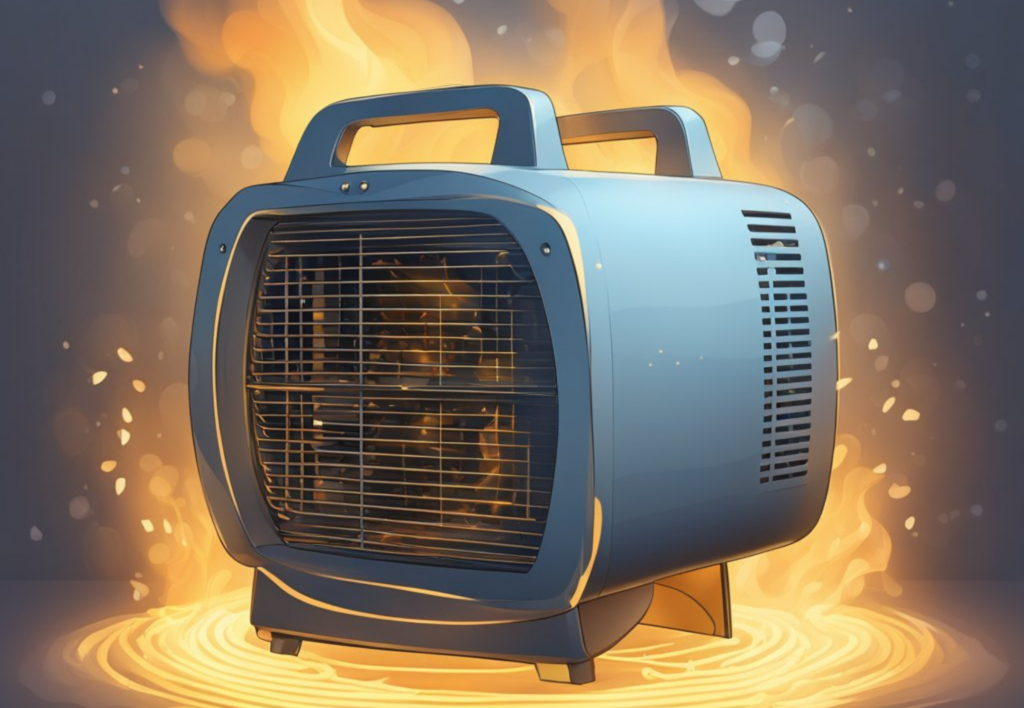
Drawbacks:
- Limited Coverage: Primarily for single-room use.
- Electricity Dependency: Require a power source.
- Long-Term Costs: Continuous use may increase electricity bills.
Cost and Lifespan:
- Cost: Ranges from $20 to $200+ based on type and features.
- Lifespan: Lasts 3 to 15 years with proper maintenance.
Ideal Applications:
- Home Offices: Localized heating without affecting the entire house.
- Bedrooms: Quiet models ensure undisturbed sleep.
- Small Apartments: Efficient for individual rooms or smaller spaces.
Safety Concerns:
- Ensure stable placement on non-flammable surfaces.
- Use GFCI outlets, avoid extension cords.
- Prefer models with auto-shutoff to reduce fire risks.
- Keep away from children and pets.
Want to learn more about electric space heaters?
Infrared Heaters
Infrared space heaters use infrared radiation to directly warm objects and individuals without heating the surrounding air.
How They Work:
- Emit infrared radiation, similar to sunlight, absorbed directly by objects and people.
- Provides efficient thermal heating by targeting and penetrating surfaces.
Key Benefits:
- Direct Heating: Immediate warmth directly to objects and people.
- Energy Efficiency: Targeted heating minimizes energy wastage.
- Quiet Operation: Silent due to the absence of fans or moving parts.
- Clean Heat: Doesn’t reduce oxygen or humidity levels.
Potential Drawbacks:
- Spot Heating: Not ideal for evenly warming larger spaces.
- Electricity Dependency: Requires a constant electrical source.
- Visible Light: Some units emit light that can be distracting.
Cost and Lifespan:
- Cost: Ranges from $50 to $200, depending on various factors.
- Lifespan: Lasts 5 to 15 years with proper maintenance.
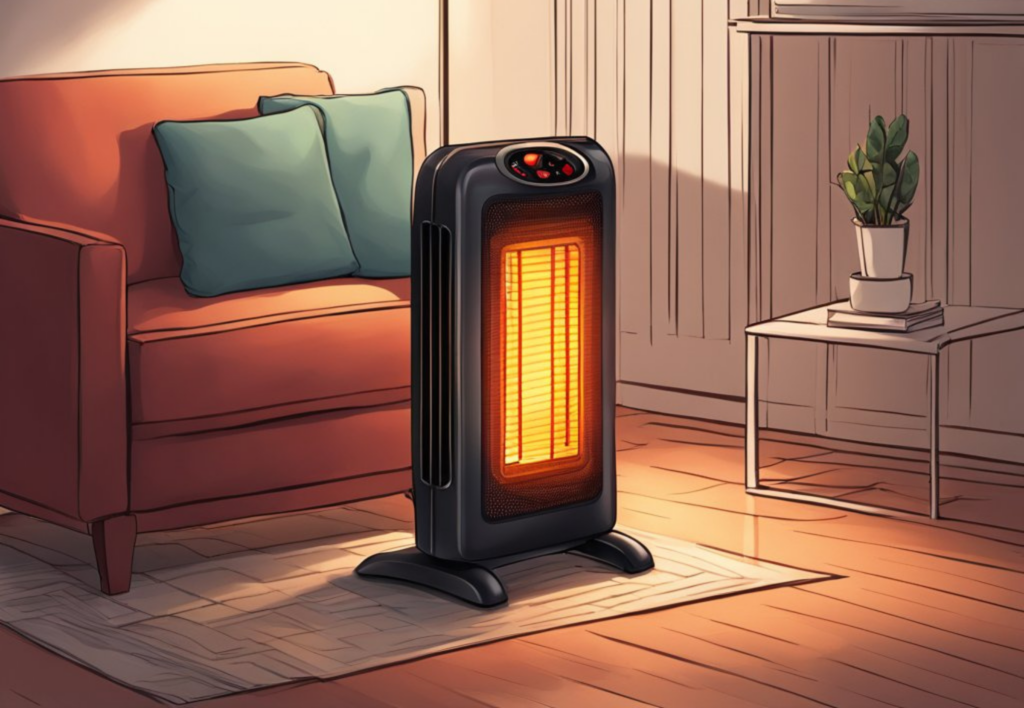
Ideal Applications:
- Patios and Outdoors: For direct warmth in open spaces.
- Workshops and Garages: Quickly heating specific areas.
- Living Areas: Directly warming seating zones, saving energy.
Safety Concerns:
- Direct Exposure: Prolonged exposure can cause discomfort or irritation.
- Placement: Should be positioned to unblock rays for maximum efficiency.
- Overheating: Choose models with automatic shut-off mechanisms.
Convection Space Heaters
These heaters work by warming air near their elements, which then rises and circulates to heat the room evenly.
How They Work:
- Heating Elements: Ceramic plates or coils are used.
- Natural Airflow: Warm air rises, cool air sinks, creating circulation.
- Consistent Heating: Gradually, the entire room reaches a uniform temperature.
Key Benefits:
- Even Heating: Offers consistent room temperature.
- Quiet Operation: Runs silently due to lack of fans or moving parts.
- Safety: Modern models often have cooler exteriors to reduce burn risks.
- Efficiency: Ideal for steadily heating larger spaces.
Potential Drawbacks:
- Slower Heating: Might take longer to warm a room.
- Electricity Dependency: Requires continuous power supply.
- Size: Can be bulkier compared to other heater types.

Cost and Lifespan:
- Price Range: $40 to $200, dependent on various factors.
- Durability: Can last between 5 to 15 years with proper care.
Ideal Usage:
- Bedrooms: For a comfortable and consistent temperature.
- Offices: Silent operation ensures no disturbances.
- Living Rooms: Effective for larger gathering areas.
Safety Considerations:
- Overheating: Auto-shutoff feature is crucial.
- Placement: Keep at a safe distance from flammable items.
- Surface Temperature: Exercise caution, especially around children and pets.
Want to learn more about convection space heaters?
Micathermic Space Heaters
Micathermic space heaters are in the spotlight for their unique advantages, combining radiant and convection heating principles.
How They Work:
- Heating Element: An electric resistive element under the mica panel.
- Mica Panel: Radiates both radiant and convection heat as it heats up.
- Efficient Warmth: Quick heating with even room temperature distribution.
- Silent Operation: No fans or moving parts for noiseless function.
Key Benefits:
- Fast Warm-Up: Provides heat rapidly.
- Energy Efficiency: Blending radiant and convection heating for better energy use.
- Quiet Operation: Silent, ensuring a peaceful environment.
- Slim Profile: Sleek design, fitting well in modern homes.
Potential Drawbacks:
- Limited Range: Radiant heat is localized, so placement is important.
- Surface Temperature: Can get quite hot, requiring careful handling.
- Higher Initial Cost: Tends to be more expensive initially.
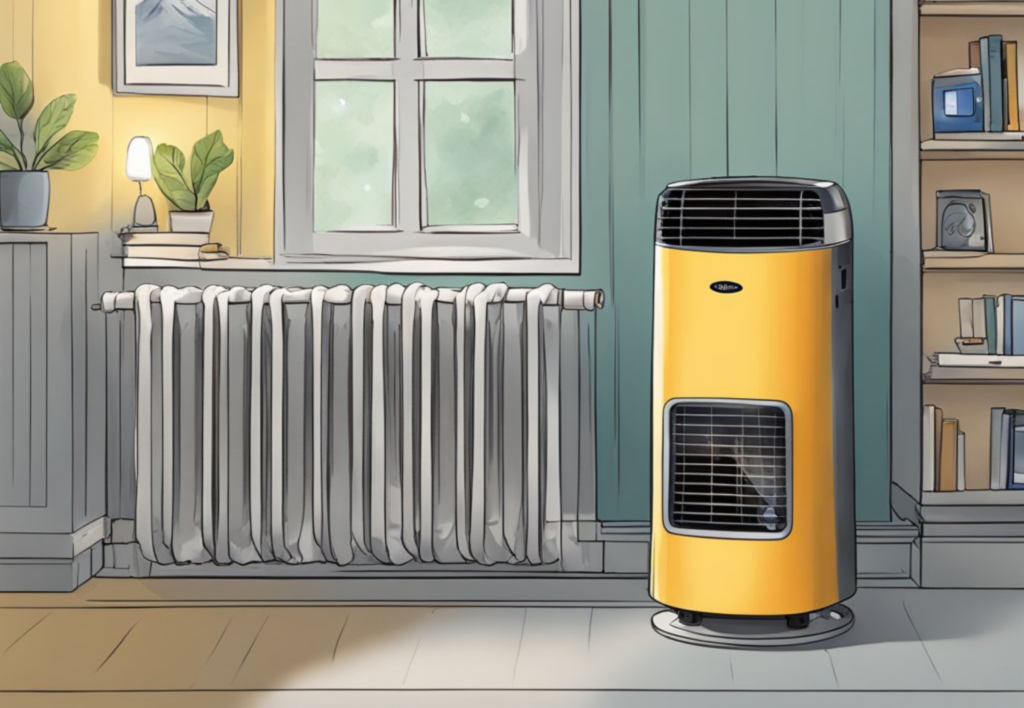
Cost and Lifespan:
- Price Range: $80 to $300, varies with brand and features.
- Durability: Lasts 5 to 10 years with regular maintenance.
Ideal Usage:
- Bedrooms: Quiet operation for undisturbed sleep.
- Living Areas: Even warmth for comfort.
- Offices: Silent, efficient heating for a productive environment.
Safety Considerations:
- Hot Surface: Exercise caution, especially near children and pets.
- Placement: Ensure adequate space around for safety and proper heat dispersion.
- Tip-over Risk: Prefer models with tip-over protection.
Want to learn more about micathermic space heaters?
Ceramic Space Heaters
Ceramic space heaters use ceramic plates and aluminum baffles to generate and disperse heat.
How They Work:
Electricity heats the ceramic plates, which then warm the aluminum baffles. The heat is then released into the room, often with the aid of a fan.
Key Benefits:
- Safety: Lower surface temperature reduces burn risks.
- Energy Efficiency: Quick room heating can potentially lower electricity costs.
- Portability: Easily movable between rooms.
- Quiet Operation: Generally quieter than other electric heaters.
Potential Drawbacks:
- Limited Area Coverage: Best for smaller spaces; less effective in larger areas.
- Electricity Dependency: Non-functional without electricity.
- Long-Term Costs: Electricity costs can accumulate over time.
Cost and Lifespan:
- Cost: Ranges from $30 to $150, influenced by brand, power, and features.
- Lifespan: Lasts 3 to 10 years with proper maintenance.
Ideal Applications:
- Home Offices: Localized heating without warming the entire house.
- Bedrooms: Silent operation for undisturbed sleep.
- Small Living Spaces: Efficient for compact areas.
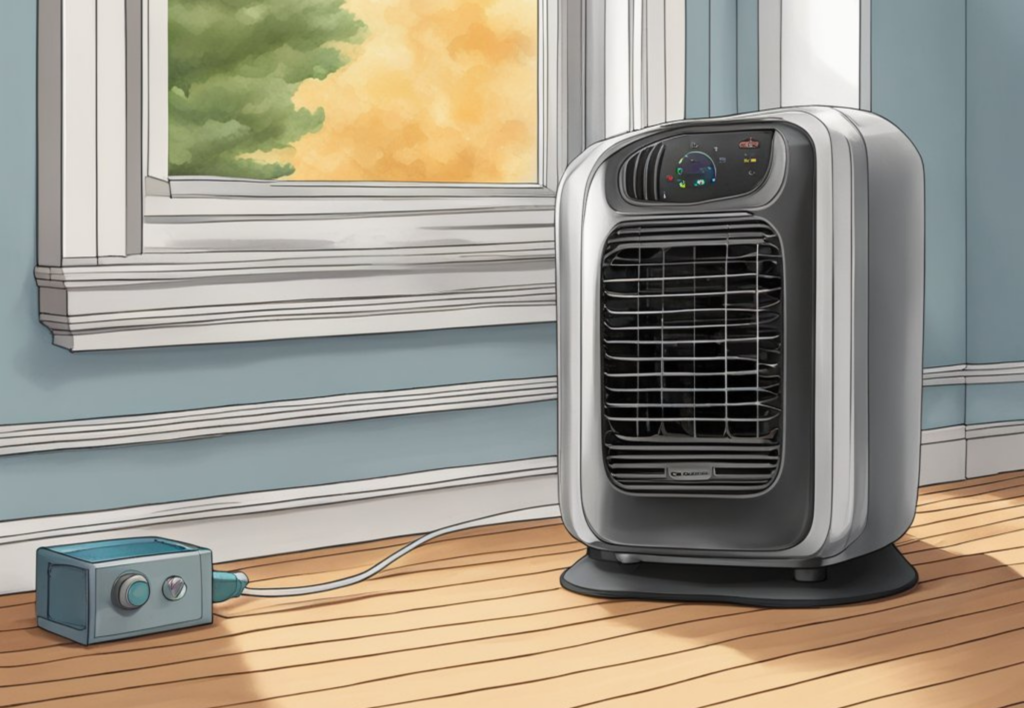
Safety Concerns:
- Placement: Should be on a flat, non-flammable surface.
- Electrical Safety: Use a GFCI outlet for power-related safety.
- Overheating: Prefer models with auto-shutoff features.
- Children and Pets: Keep out of reach to prevent burns or tipping.
Safety Certifications:
- Look for NRTL approvals, such as a UL seal.
- Essential features include a tip-over switch and thermostatic control.
Want to learn more about ceramic space heaters?
Oil-Filled Radiator Space Heaters
Oil-filled space heaters, also known as radiant heaters, use heat-conserving oil circulated within a metal casing to produce warmth.
How They Work:
- Heat the oil via a heating element.
- The heated oil circulates through the fins, dispersing heat into the room.
- They’re more energy-conserving due to lower power consumption over time.
Benefits:
- Safety: Cooler surface reduces burn risks.
- Energy Efficiency: Maintains warmth longer, even after being switched off.
- Silent Operation: No fans or moving parts.
- Consistent Warmth: Provides even and steady heat.
Drawbacks:
- Slower Heat Up: Takes time to initially warm up spaces.
- Size and Weight: Generally bulkier and heavier.
- Surface Temperature: Can still become warm to the touch.
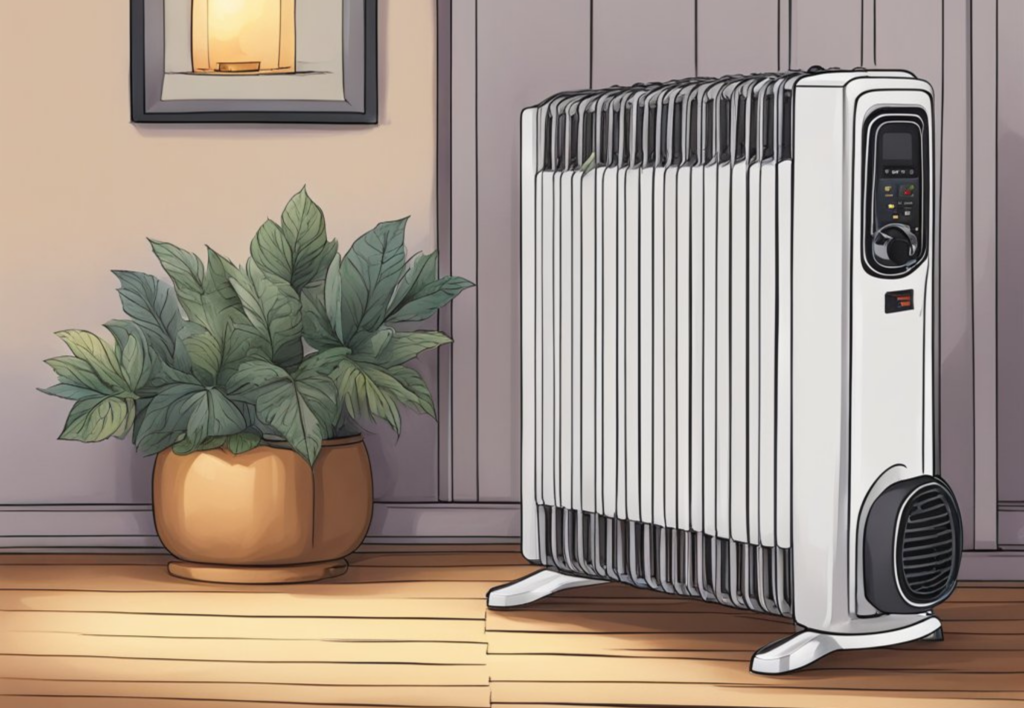
Cost and Lifespan:
- Cost: Ranges from $40 to $200, depending on features and brand.
- Lifespan: Lasts 5 to 15 years with proper usage and care.
Ideal Applications:
- Living Rooms: For uniform heating of larger spaces.
- Bedrooms: Silent operation for undisturbed sleep.
- Bathrooms and Basements: Effective in moisture-prone or colder areas.
Safety Concerns:
Ensure stable placement and ample space around the heater and use caution around children and pets.
Want to learn more about oil-filled space heaters?
Radiant Space Heaters
Radiant space heaters are gaining traction for their distinct advantages.
How They Work:
- Infrared Radiation: Emit infrared rays to warm objects and people directly.
- Immediate Warmth: Provide instant heat, unlike convection heaters.
- Efficiency: Heat only what’s directly in their path, reducing energy wastage.
- Silent Operation: Lack of fans ensures quiet functioning.
Key Benefits:
- Direct Warm-Up: Immediate warmth to objects and people.
- Energy Efficiency: Only heat what’s in their path, saving energy.
- Quiet Operation: Operate silently, ideal for noise-sensitive areas.
- Portability: Easy to move from room to room.
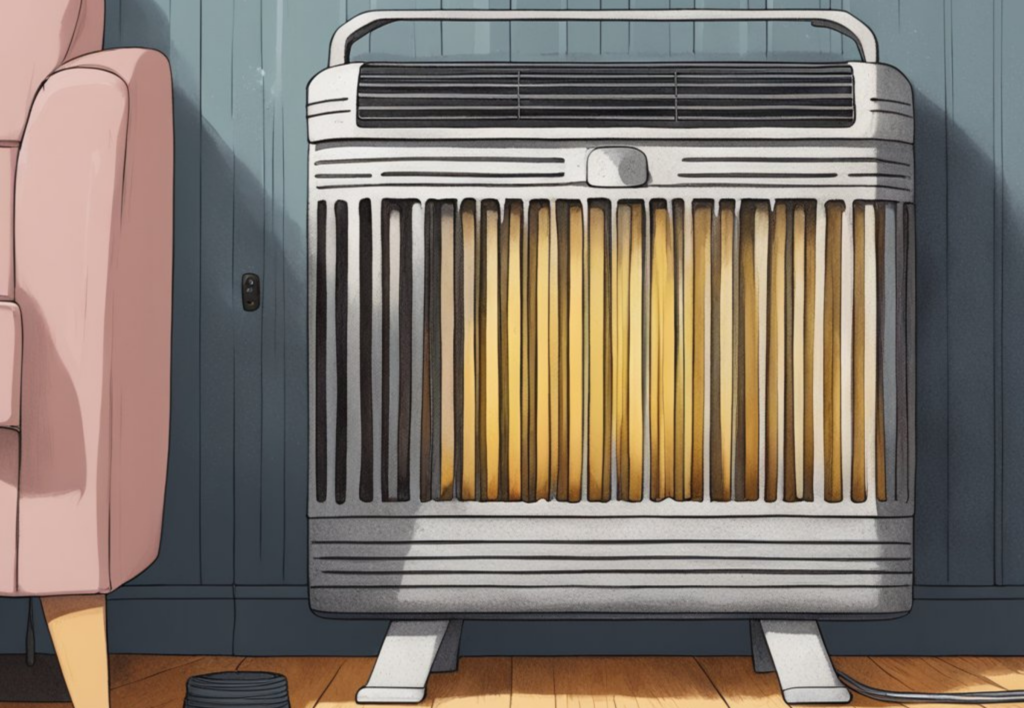
Potential Drawbacks:
- Limited Coverage: Mainly heat areas directly in front of them.
- Surface Temperature: Can get hot, requiring caution.
- No Ambient Warmth: Don’t warm the air, which might not suit all users.
Cost and Lifespan:
- Price Range: $30 to $200, varies by brand and features.
- Durability: Lasts between 3 to 10 years with proper care.
Ideal Usage:
- Garages & Workshops: Useful in drafty spaces for immediate warmth.
- Living Areas: Spot heating for sitting or working.
- Bedrooms: Direct warmth without noise, ensuring restful sleep.
Want to learn more about radiant space heaters?
Propane Space Heaters
They work by burning propane gas, providing instant warmth.
Functionality:
- Combustion Chamber: Ignites propane gas to produce heat.
- Heat Distribution: Some use fans, others rely on radiant heating.
- Fuel Storage: Connects to varying-sized propane tanks.
- Energy Efficiency: High heat output per unit of fuel.
- Portability: Easily movable for flexible heat placement.
Benefits:
- Instant Heat: Quick warming of spaces.
- Portability: Easy to move.
- No Electricity Required: Suitable for power outages or remote locations.
- High BTU Output: Significant heat relative to size.
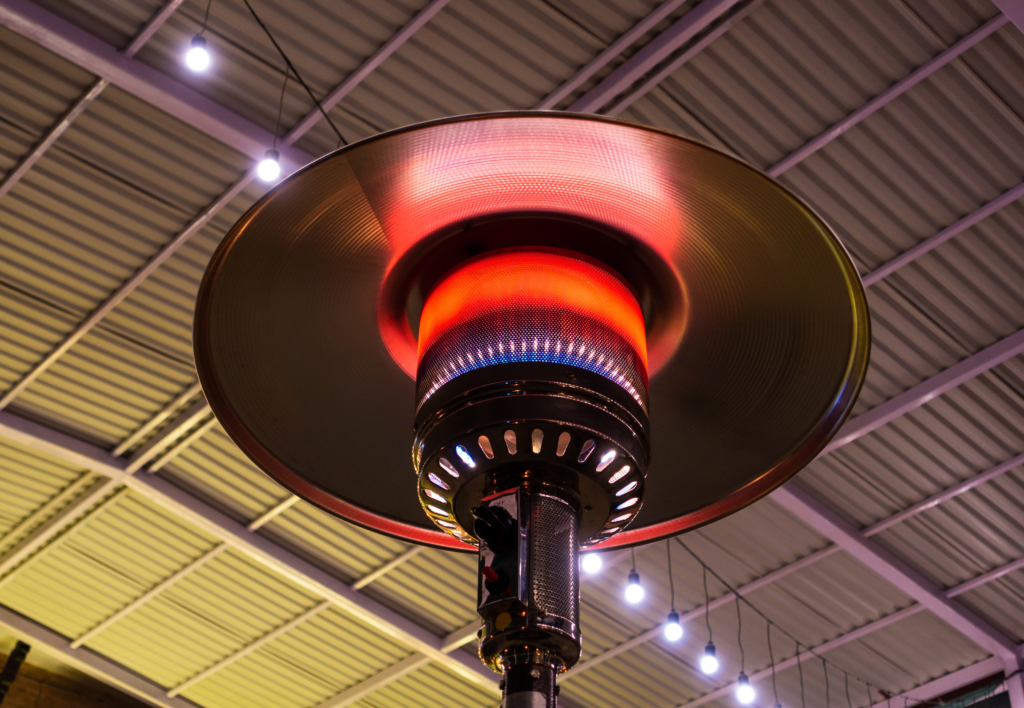
Drawbacks:
- Fuel Dependency: Regular refills or a connected source needed.
- Ventilation Requirement: To avoid gas accumulation.
- Surface Temperature: Parts can get extremely hot.
- Safety Concerns: Risk of carbon monoxide buildup.
Cost and Lifespan:
- Cost: Ranges from $80 to $400.
- Lifespan: 5 to 15 years with regular maintenance.
Ideal Applications:
- Outdoor settings (patios, decks).
- Workshops (with proper ventilation).
- Camping.
Safety Considerations:
- Adequate ventilation to avoid carbon monoxide.
- Keep away from flammable materials.
- Ensure stable placement.
Want to learn more about propane space heaters?
Halogen Light Space Heaters
Halogen space heaters stand out for their unique qualities.
How They Work:
- Halogen Bulbs: They emit heat and light when electricity is passed through.
- Instant Heat: Provides immediate warmth when switched on.
- Infrared Radiation: Emits infrared rays for direct warming of objects and people.
- Quiet Operation: Fanless design ensures silent functioning.
Key Benefits:
- Rapid Warmth: Offers quick heat relief.
- Energy Efficiency: Directly warming objects is more energy-efficient than heating air.
- Portability: Lightweight and easy to move around.
- Silent Operation: Ideal for bedrooms or study areas due to the lack of noise.
Potential Drawbacks:
- Area Coverage: Only heats objects and people in its direct path.
- Bulb Lifespan: Halogen bulbs need replacement over time.
- Surface Temperature: Heater surface can become very hot.
Cost and Lifespan:
- Price Range: $25 to $150, varies by brand and features.
- Durability: Lasts around 3 to 7 years with proper maintenance.
Ideal Usage:
- Personal Desks: Perfect for spot heating while working.
- Bedrooms: Noise-free warmth for better sleep.
- Living Areas: Direct heating while relaxing or watching TV.
Safety Considerations:
- Hot Surface: Be cautious around children and pets.
- Placement: Keep away from flammable materials.
- Overheating: Prefer models with overheat protection.
Want to learn more about halogen space heaters?
Panel Space Heaters
Panel space heaters, also known as convection heaters, use flat panels to distribute heat, warming air directly around them and allowing it to rise and spread warmth evenly.
How They Work:
- Heating Elements: Electric heating element heats up when electricity flows through.
- Convection Process: Hot air rises, creating a convection current that evenly heats the space.
- Panel Design: Flat panels maximize surface area for heat distribution.
- Energy Efficiency: Particularly efficient for heating individual rooms.
- Mounting and Portability: Wall-mountable design saves space and offers portability.
Benefits:
- Wall-Mountable: Space-saving, yet portable.
- Energy Efficiency: Uniform heat distribution reduces energy waste.
- Silent Operation: No fans or moving parts.
- Aesthetic Design: Sleek and modern appeal.
Drawbacks:
- Slower Heating: Takes longer to warm a room than other heaters.
- Electricity Dependency: Continuous power source needed.
- Hot Surface: Requires caution due to heat.
- Installation: Wall or floor mounting can require extra work.
Cost and Lifespan:
- Cost: Ranges from $60 to $250.
- Lifespan: Lasts 5 to 12 years with proper maintenance.
Ideal Applications:
- Bedrooms: Silent and even heating.
- Offices: Sleek design suitable for professional settings.
- Living Areas: Uniform warmth for comfort.
Safety Considerations:
- Hot Surface: Keep away from children and pets.
- Proper Placement: Ensure space for heat dispersion.
- Overheating: Opt for models with built-in thermostats and auto-shutoff.
Want to learn more about panel space heaters?
Pellet Stove Space Heaters
Pellet stove heaters are an increasingly popular choice for their efficiency and eco-friendliness. Utilizing compressed wood or biomass pellets, these stoves ensure consistent warmth through an automated feed system and built-in fans.
Key Benefits:
- High Combustion Efficiency: Superior to traditional wood stoves.
- Eco-Friendly: Lower emissions due to cleaner burning pellets.
- Ease of Use: Automated systems for hassle-free operation.
- Consistent Heating: Steady warmth unlike fluctuating outputs of traditional fireplaces.
Potential Drawbacks:
- Fuel Dependency: Relies on a consistent supply of pellets.
- Electricity Requirement: Essential for operating automated systems and fans.
- Maintenance: Regular cleaning and upkeep are needed.
- Initial Cost: Generally higher than some other heating options.
Cost and Lifespan:
- Price Range: $1,000 to $3,000, influenced by various factors.
- Durability: Can last 15 to 20 years with proper maintenance.
Ideal Usage:
- Living Rooms: Enhances ambiance while providing warmth.
- Large Spaces: Efficiently heats larger areas.
- Regions with Pellet Accessibility: Best used where pellets are readily available.
Safety Considerations:
- Installation: Must be installed correctly with proper venting.
- Pellet Storage: Keep pellets dry and away from the stove.
- Cleaning: Regular ash pan cleaning and inspection are necessary.
- Certifications: Look for UL seal or other safety certifications.
Want to learn more about pellet stove space heaters?
Comparing Different Types of Space Heaters
Below is a table summarizing the key features, benefits, drawbacks, cost, lifespan, ideal applications, and safety considerations for various types of space heaters:
| Type | Features | Benefits | Drawbacks | Cost | Lifespan |
|---|---|---|---|---|---|
| Electric | Multiple types | Safe, efficient | Limited range | $20-$200+ | 3-15 yrs |
| Infrared | Direct heating | Efficient, quiet | Spot heating | $50-$200 | 5-15 yrs |
| Convection | Natural airflow | Even heating | Slower heat-up | $40-$200 | 5-15 yrs |
| Micathermic | Mica panel | Fast, slim | Limited range | $80-$300 | 5-10 yrs |
| Ceramic | Fan-assisted | Safe, quiet | Limited area | $30-$150 | 3-10 yrs |
| Oil-Filled | Heat-conserving oil | Silent, consistent | Slower, heavy | $40-$200 | 5-15 yrs |
| Radiant | Immediate warmth | Direct heat | Limited coverage | $30-$200 | 3-10 yrs |
| Propane | Fuel storage | Instant heat | Ventilation needed | $80-$400 | 5-15 yrs |
| Halogen | Halogen bulbs | Rapid warmth | Limited area | $25-$150 | 3-7 yrs |
| Panel | Flat panels | Wall-mountable | Slower heating | $60-$250 | 5-12 yrs |
| Pellet Stove | Biomass pellets | Eco-friendly | Maintenance | $1,000-$3,000 | 15-20 yrs |
Each row provides a quick overview of the heater type, its key features, benefits, drawbacks, cost, and expected lifespan.
Here are some direct comparisons that we’ve put together:
Oil-filled space heaters vs ceramic
Factors to Consider When Choosing a Space Heater
Room Size
Heater Capacity
Also, durability is a big deal when it comes to space heaters – learn more about the lifespan of space heaters and how to maximize it!
Energy Efficiency and Cost-Effectiveness
Safety Features
Modern space heaters have evolved with various safety features that are important to understand.
- Tip-over Protection
- What It Is: Shuts off the heater if it’s knocked over.
- Why It Matters: Prevents fires, conserves energy.
- Tips: Place in a stable location, check functionality annually.
- Overheat Protection
- What It Is: Turns off the heater if it overheats.
- Why It Matters: Prevents fire risks, protects internal components.
- Tips: Keep vents clean, allow cooling before restarting.
- Cool-touch Exteriors
- What It Is: Exterior stays cool during operation.
- Why It Matters: Reduces burn risk, prevents scorching materials.
- Tips: Especially important around children.
- Ground Fault Circuit Interrupter (GFCI) Plug
- What It Is: Cuts off power if there’s an electric shock risk.
- Why It Matters: Enhances electrical safety, prevents short-circuits.
- Tips: Essential for damp areas, test regularly.
- Oxygen Depletion Sensor (ODS)
- What It Is: Shuts off heater if oxygen levels drop.
- Why It Matters: Prevents carbon monoxide build-up, ensures air safety.
- Tips: Crucial for gas heaters, maintain sensor.
- Programmable Timer
- What It Is: Automatically turns off after set time.
- Why It Matters: Saves energy, enhances safety.
- Tips: Great for bedtime use, combine with overheat protection.
- Child Safety Lock
- What It Is: Locks settings to prevent unintentional changes.
- Why It Matters: Prevents misuse, peace of mind for caregivers.
- Tips: Always activate when not in use or unattended.
Want a more detailed overview of space heater safety features or the most helpful space heater safety tips?
Noise Level
When considering the purchase of a space heater, noise level is an important factor to take into account, especially if you are sensitive to sound or plan to use it in a quiet environment like a bedroom or an office.
The type of space heater you should buy can greatly depend on your tolerance for noise and the intended use of the heater.
Types of Space Heaters and Their Noise Levels:
- Convection Heaters (including Oil-filled Radiators):
- Noise Level: Generally very quiet.
- Ideal for: Bedrooms, offices, or any place where minimal noise is desired.
- Why: These heaters work by circulating warm air through the room and are typically silent since they don’t use a fan.
- Ceramic Heaters:
- Noise Level: Moderate.
- Ideal for: Living rooms, workshops, or areas where some noise is acceptable.
- Why: These heaters have fans to distribute heat, which can cause some noise, but they are usually quieter than traditional fan heaters.
- Fan-forced Heaters:
- Noise Level: Can be noisy.
- Ideal for: Garages, workshops, or areas where noise is not a major concern.
- Why: The fan mechanism used to distribute heat can be loud, especially on higher settings.
- Infrared or Radiant Heaters:
- Noise Level: Very quiet to silent.
- Ideal for: Bedrooms, quiet offices, or spaces where you want targeted heat without noise.
- Why: They emit infrared radiation to heat objects and people directly, requiring no fan.
- Micathermic Heaters:
- Noise Level: Quiet.
- Ideal for: Bedrooms or living areas where you want a quiet but effective heat source.
- Why: These heaters combine convection and radiant heating, thus not relying heavily on fans.
If you are struggling with a noisy space heater you might want to read more about this!
Portability
Portability and design are significant factors when choosing a space heater, as they can greatly influence the convenience, aesthetic appeal, and suitability of the heater for different spaces and needs.
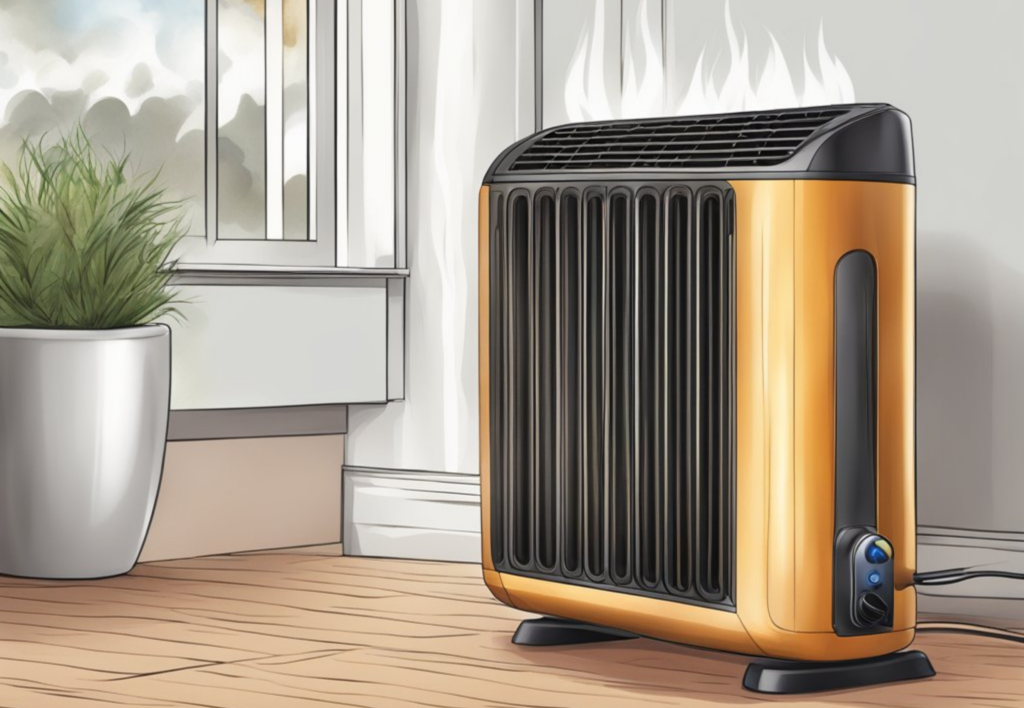
Weight and Size:
Lightweight and compact heaters are easier to move from room to room. If you plan to use the heater in multiple locations, consider a model that’s easy to carry.
Larger, heavier heaters might provide more heating power but are less portable.
Handles and Wheels:
Look for heaters with built-in handles or wheels, especially for larger models. These features make it much easier to transport the heater safely.
Cord Length:
A longer power cord increases flexibility in placement and reduces the need for extension cords, which are generally not recommended for space heaters.
Safety Features:
For portable heaters, safety features like tip-over protection and automatic shut-off are important, especially if you’ll move the heater frequently.
Design
Aesthetics:
Space heaters come in various styles, from modern to traditional. Choose a design that complements your room’s decor.
Sleek, minimalistic heaters often blend well in contemporary spaces, while more classic designs might suit traditional decor.
Footprint:
Consider the amount of floor or surface space the heater will occupy. Slim, tower-style heaters take up less floor space and can be ideal for smaller rooms.
Wall-mounted options are available for those who prefer not to use floor space at all.
Heating Method:
The design often correlates with the heating method (e.g., oil-filled radiators, ceramic heaters, infrared heaters). Choose a design that aligns with the type of heat distribution you prefer.
Control Panel:
Easy-to-use control panels with clear settings are important for convenience. Some heaters offer digital displays and remote controls for added ease.
Noise Level:
As mentioned previously, design can influence noise level. Sleeker designs with fewer moving parts tend to be quieter.
Integrated Features:
Some heaters come with additional features like built-in humidifiers, air purifiers, or oscillation for broader heat distribution. Consider if these features align with your needs.
Additional Features (thermostat, timer, remote control, etc.)
Space heaters come with a range of features that enhance their usability and performance, such as:
- Targeted heating capabilities to warm specific areas.
- Energy-efficient operations, especially in models like quartz heaters that heat objects directly.
- Dual functionality, with some heaters serving as both heaters and fans for use across different seasons.
- Auto climate control to evenly distribute warm air and maintain consistent room temperature.
- ECO modes that reduce energy consumption while providing rapid and even heating.
- Programmable thermostats for easy setting adjustments and potential heating cost savings.
- Smart functionality, allowing control via smartphone or voice commands.
- Compact and vertical designs suitable for small spaces, providing both heating and cooling options with easy control via digital panels and remote controls.
Safety and Precautions When Using Space Heaters
Common Hazards Associated with Space Heaters
Space heaters, though beneficial, come with risks. It’s crucial to be aware of potential hazards and the safety features designed to mitigate them.
- Hazard: Tip-Over Accidents
- Solution: Tip-over Protection that automatically turns off the heater if it’s knocked over.
- Hazard: Overheating
- Solution: Overheat Protection that shuts off the heater if internal temperatures get too high.
- Hazard: Contact Burns
- Solution: Cool-touch Exteriors keep the heater’s surface cool to prevent burns upon touching.
- Hazard: Electrical Mishaps
- Solution: Ground Fault Circuit Interrupter (GFCI) Plug that cuts power during electrical shock risks.
- Hazard: Reduced Oxygen Levels
- Solution: Oxygen Depletion Sensor (ODS) that turns off the heater if oxygen levels drop dangerously low.
- Hazard: Unnecessary Prolonged Operation
- Solution: Programmable Timer that automatically turns off the heater after a set period.
- Hazard: Unintentional Setting Changes
- Solution: Child Safety Lock that prevents accidental alteration of heater settings.
- Hazard: Inconsistent Room Temperature
- Solution: Digital Thermostats and Display for maintaining a stable room temperature.
- Hazard: Lack of Supervision
- Solution: Wi-Fi Connected Heaters that allow for remote monitoring and control.
For more details on the most common space heater hazards we’ve put together a resource for your!
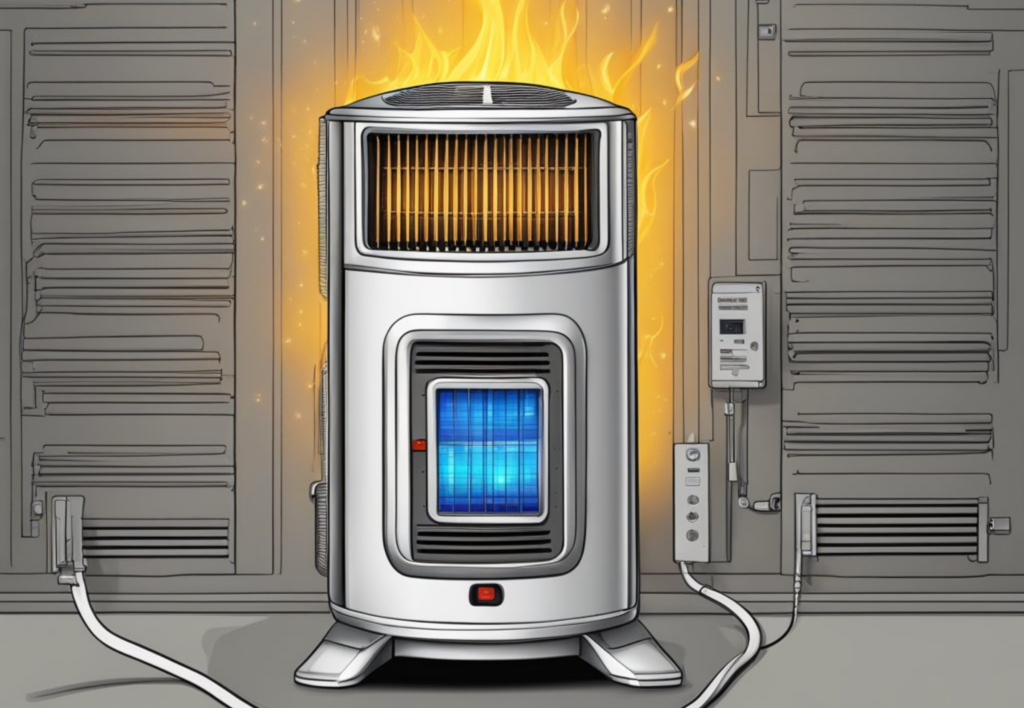
Safety Tips for Using Space Heaters
This section highlights key safety practices, distilled from expert advice, personal experiences, and in-depth research, to ensure safe and effective use of space heaters.
Core Safety Measures for space heaters:
- Maintain Distance: Keep a minimum of 3 feet clear around the heater to prevent fire risks.
- Stable Placement: Always place the heater on a hard, flat surface to avoid tipping over.
- Dry Environment: Use the heater in dry areas only, steering clear of any moisture to prevent electrical hazards.
- Avoid Extension Cords: Plug the heater directly into a wall outlet to prevent overheating and potential fires.
- Regular Inspections: Check the heater for signs of damage or wear before use to prevent malfunctions.
- Supervise Operation: Never leave the heater unattended to quickly address any potential issues.
- Manufacturer’s Guidelines: Follow the instructions provided by the manufacturer for safe and efficient use.
- Adequate Ventilation: Ensure good airflow, particularly with fuel-burning heaters, to avoid toxic gas buildup.
- Install Detectors: Equip spaces with smoke and carbon monoxide detectors as a precautionary measure.
Here are those space heater safety tips in more detail!
Best Practices for Placement and Operation
For optimal efficiency and safety when using space heaters, consider the following
- Selecting the Right Surface:
- Place the heater on solid ground, not on tables or elevated platforms, especially if it’s large.
- Safe Distancing:
- Keep at least a three-foot clearance from beds, furniture, and walls.
- Follow manufacturer’s guidelines for heaters near walls.
- Optimal Positioning:
- Avoid placing near windows or doors to reduce heat loss.
- Place centrally for even heat distribution.
- Power Connection:
- Plug directly into wall outlets, avoiding extension cords.
- Check that the outlet meets the heater’s power requirements.
- Placement in Multi-Story Homes:
- Positioning on the ground floor can effectively warm upper levels.
- Circulation and Ventilation: Ensure proper airflow, especially for gas heaters. Keep a safe distance from walls and avoid drafty areas.
- Human and Pet Safety:
- Keep heaters away from high-traffic zones.
- Establish a 3-foot kid- and pet-free zone around the heater.
- Consider special pet-friendly heaters with safety features.
- Room-Specific Placement Considerations:
- Bathrooms: Keep away from water sources and damp floors.
- Patios: Use outdoor-specific heaters and place them away from flammables.
- Basements and Hallways: Central placement is effective.
- Places to Avoid: Never place the heater near flammable materials, in damp areas, on unstable surfaces, or too close to walls.
Following these guidelines can significantly enhance your space heater’s effectiveness while ensuring safety and comfort in your home.
For more details on where to place your space heater we have a resource for you!
Also, do you ever wonder whether or not you can put a space heater on carpet?
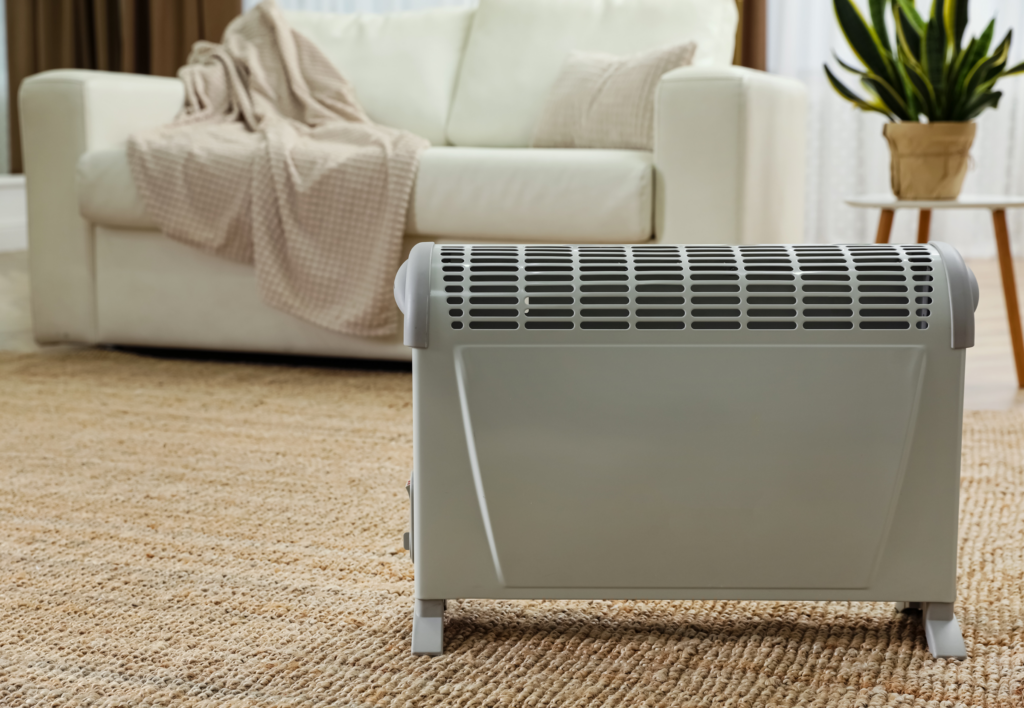
Troubleshooting Common Issues with Space Heaters
When your space heater is making noises
Space heaters are a popular choice for warming up rooms during colder months. However, they can sometimes produce various noises during operation. Understanding these sounds is crucial for both safety and optimal functioning.
Types of Noises and Solutions:
- Crackling Noise: Often a result of heater components heating up. It can be due to a dirty filter or blocked vents.
- Solution: Clean the filter, remove obstructions, and recognize this as a normal heater operation sound.
- Clicking Sound: Caused by the expansion and contraction of internal materials.
- Solution: Store the heater in a warm location and ensure proper assembly.
- Humming Noise: Linked to the motor or fan. It indicates normal operation or issues with these components.
- Solution: Check for loose parts if the humming is excessive and consult a professional if needed.
- Screeching or Squealing: Suggests electrical complications or friction in moving metal parts.
- Solution: Inspect cords and seek professional help if needed.
- Rattling Noise: Indicates loose components or debris.
- Solution: Secure any loose parts and clean as necessary.
- Buzzing Noise: Points towards electrical problems.
- Solution: Ensure tight connections and consult an expert if unsure.
- Popping Sound: Common during sudden temperature changes.
- Solution: Recognize it as a typical sound during operation.
- Sizzling Sound: Suggests moisture presence.
- Solution: Store in a dry, warm place.
Potential Dangers:
Noisy heaters can indicate issues like dust build-up or overheating, which may lead to electrical arcs or fire hazards. Regular cleaning, inspection for wear, using surge protectors, and adhering to safety guidelines are crucial.
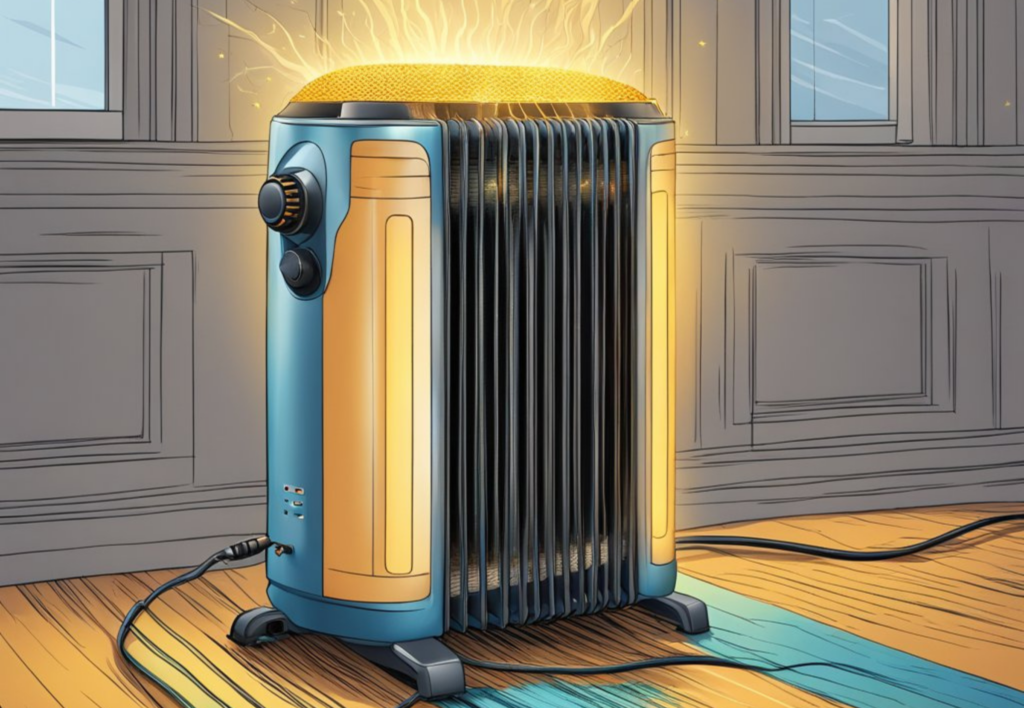
Preventive Measures:
Maintaining your space heater is key. Regularly clean filters, ensure the surrounding area is clear, inspect cords and plugs, and consider oil-filled radiators for quieter operation.
By understanding these noises and taking appropriate actions, you can ensure your space heater’s safe and efficient operation throughout the winter months.
For more details on common space heater noises and what to do about them, we have a full guide!
When your space heater smells
Space heaters can produce different smells due to various reasons. It’s essential to identify and fix these for safety and efficiency.
- Burning Chemicals, Residues, or Oils: New heaters might emit this due to manufacturing residues.
- Solution: Run new heaters in ventilated areas, clean external surfaces, inspect internal parts, and consult the manual.
- Burning Dust: Common in heaters after long disuse.
- Solution: Clean the space heater regularly, especially before use after storage, and ensure good ventilation.
- Burning Plastic: Could indicate overheating or damage.
- Solution: Inspect for melting or damage, avoid obstructions, and consult a professional if needed.
- Burning Rubber: May be caused by overheated rubber components.
- Solution: Immediately turn off and check for damage. Consult a technician and consider replacement if necessary.
- Burning Hair: Occurs when hair or fur gets into the heater.
- Solution: Clean regularly, especially vents and surfaces, and position away from pet-heavy areas.
- Burning Electrical Wires: Indicates serious electrical issues.
- Solution: Immediately turn off and unplug. Inspect wiring, avoid DIY fixes, consult a professional, and consider replacing the heater.
In all cases, safety should be the top priority. Regular maintenance, proper storage, and following manufacturer guidelines can prevent many of these issues.
For more details on the most common space heater smells (along with fishy space heater smells) and what to do about them, we have a full guide!
When your space heater shuts off
Space heaters can unexpectedly turn off due to various reasons. Understanding these can aid in swift troubleshooting:
- Overheating: Due to blocked airflow or prolonged use. Fix by clearing vents, cleaning filters, and allowing the heater to cool.
- Tilt or Tip-Over Switch: Safety feature activates if heater is knocked over. Ensure it’s on a stable surface and reset if needed.
- Thermostat Settings: Incorrect settings can cause frequent cycling. Adjust for desired warmth and check placement.
- Electrical Issues: Damaged power cords or outlet problems. Inspect cord and try different outlets.
- Internal Component Failure: Might need professional repair. Check for unusual sounds or smells.
- Circuit Overload: Too many devices on one circuit. Use heater on a dedicated circuit or unplug other devices.
- Timer Function: Inadvertent timer settings can cause shutoffs. Adjust or disable timer as needed.
- Remote Control or Digital Settings: Check for software glitches or misconfigurations. Reset or refer to manual.
- External Thermostat: Ensure accurate thermostat settings and placement.
- Dusty Environment: Clean vents and grills regularly.
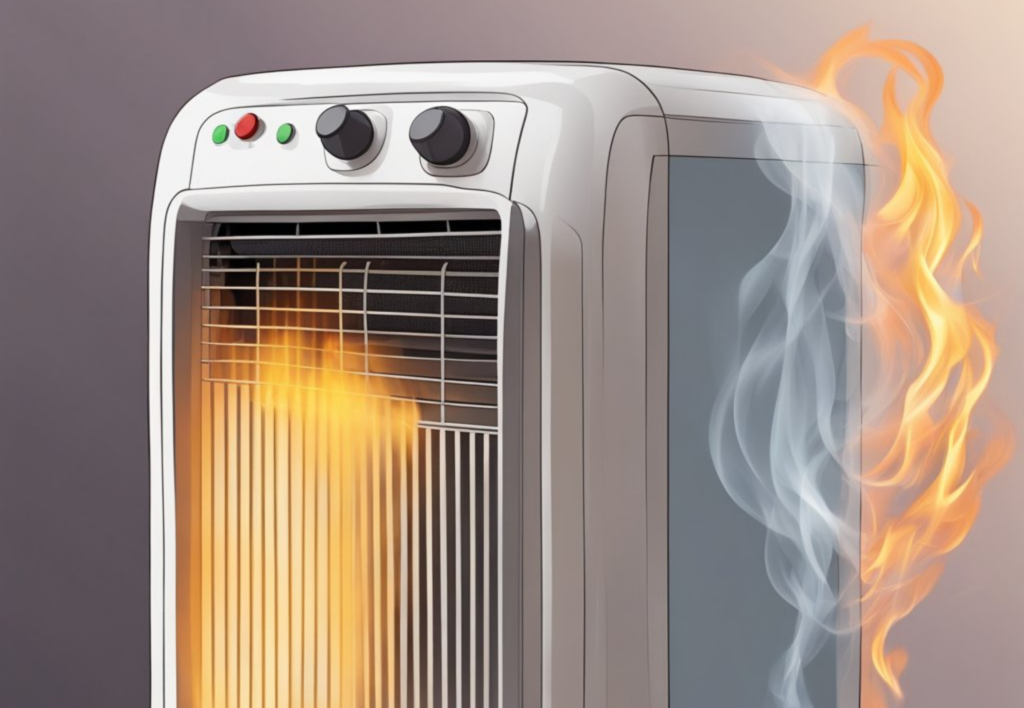
Maintenance Tips:
- Clean regularly.
- Replace filters as needed.
- Inspect power cords.
- Store in a dry, dust-free place.
- Consult the user manual for specific care instructions.
Regular maintenance enhances the lifespan and efficiency of your space heater.
Here is our full guide to how to fix a space heater that keeps turning off!
When your space heater won’t turn on
1. Power Supply Problems
Symptoms: No indicator lights, Absence of operational sounds or vibrations
Solutions:
- Check and secure the plug in the outlet
- Test the heater in another outlet
- Inspect and reset any tripped circuit breakers
2. Faulty Power Cord
Symptoms: Visible damage like fraying or cuts, Heater acting up when cord is moved
Solutions:
- Avoid using extension cords; stick to the original cord
- Regularly inspect for damage
- Replace the cord if necessary
3. Overheat Protection Activation
Symptoms: Heater shutting off unexpectedly, Overheating exterior
Solutions:
- Ensure clear airflow, remove blockages
- Clean internal dust
- Perform manual reset after cooling
4. Tilt or Tip-over Switch Issues
Symptoms: Space heater not working when upright, Shuts down when moved
Solutions:
- Place on a stable surface
- Inspect and possibly replace the switch
- Check the manual for reset procedures
5. Thermostat Malfunctions
Symptoms: Heater not responding to cold temperatures or blows cold air, Continuous operation without cycling off
Solutions:
- Cross-check with another thermometer
- Adjust settings
- Consider thermostat replacement
6. Internal Component Failure
Symptoms: Strange noises like buzzing, Diminished heat output
Solutions:
- Visually inspect accessible parts
- Seek professional diagnosis
- Replace faulty components
7. Dusty or Dirty Components
Symptoms: Visible dust on vents, Reduced airflow
Solutions:
- Clean external vents regularly
- Open casing for internal cleaning, if possible
- Replace or clean filters
8. Faulty On/Off Switch
Symptoms: Loose or non-clicking switch, No response when toggled
Solutions:
- Inspect visually for damage
- Test continuity with a multimeter
- Replace switch if needed
9. Worn Out Internal Fuse
Symptoms: Power loss after a surge, Visible fuse damage
Solutions:
- Locate and access the fuse
- Test with a multimeter
- Replace with an identical fuse
10. Age Factor
Older heaters might present multiple issues due to component degradation.
Symptoms: Frequent breakdowns, Outdated design
Solutions:
- Perform regular maintenance
- Weigh efficiency against repair costs
- Ensure safety features are up to date
Here is our full guide on how to fix a space heater that won’t turn on!
When your space heater keeps tripping the breaker
Based on my experience, there are 10 main reasons for when a space heater keeps tripping the breaker:
1. Circuit Overload
Signs: Frequent breaker trips, dimming lights.
Solution: Use the heater on a dedicated circuit; unplug other devices when using the heater.
2. Faulty Wiring
Signs: Warm outlets, burning smell, frequent trips.
Solution: Get the wiring inspected and repaired by an electrician.
3. Space Heater Malfunction
Signs: Trips regardless of outlet, unusual sounds/smells.
Solution: Repair or replace the heater.
4. Weak or Aging Circuit Breaker
Signs: Frequent trips, physical wear.
Solution: Replace the breaker.
5. High Heater Wattage
Signs: Trips when high-wattage heater is used.
Solution: Use a heater with appropriate wattage for the circuit.
6. Short Circuit in Heater
Signs: Smoke, charred plugs, sparks.
Solution: Stop using and get the heater repaired or replaced.
7. Ground Fault
Signs: Tingling sensation, immediate trips.
Solution: Get the heater inspected and fixed.
8. Inconsistent Voltage Supply
Signs: Other appliances malfunctioning, flickering lights.
Solution: Check voltage supply; use stabilizers or surge protectors.
9. Damaged Heater Switch
Signs: Difficult to operate the switch.
Solution: Repair or replace the switch.
10. Improperly Rated Breaker
Signs: Frequent trips with few devices.
Solution: Replace with a correctly rated breaker.
Here is our full guide on how to fix a space heater that keeps tripping the breaker!
Tips for Energy-Efficient Space Heater Use
Energy Efficiency and Environmental Considerations for Space Heaters
When selecting a space heater, energy efficiency is a key factor. Efficient heaters provide the same warmth while consuming less energy, reducing both your carbon footprint and electricity bills.
Energy Consumption of Space Heaters
Space heaters vary widely in their energy consumption. According to the U.S. Department of Energy, small space heaters typically consume between 750 and 1,500 watts of power. The efficiency of these heaters largely depends on their type and usage. For example, an infrared heater can be more energy-efficient for direct spot heating, whereas oil-filled radiators might be better for heating a whole room evenly.
Using a space heater with a built-in thermostat can also conserve energy. Thermostats regulate temperature, preventing the space heater from running unnecessarily. The Energy Saving Trust notes that reducing room temperature by just 1°C can cut heating bills by up to £80 per year.
Environmental Impact of Different Heater Types
- Electric Heaters: These are the most common but can have a high environmental impact if the electricity is sourced from non-renewable resources.
- Gas Heaters: Gas heaters generally have a lower carbon footprint than electric heaters, assuming the gas is used efficiently. However, they can emit pollutants and require proper ventilation.
- Oil-Filled Radiators: These are more energy-efficient than some electric heaters but can be slower to heat up. The oil is not burned, so it does not emit pollutants.
- Infrared Heaters: These heaters emit rays that directly warm objects and people, making them more energy-efficient for spot heating.
Renewable Energy Options
Utilizing renewable energy sources for space heaters is an emerging trend, reflecting a growing commitment to sustainability. While the market for solar-powered or wind-powered space heaters is still in development, some manufacturers are experimenting with integrating renewable energy capabilities into their designs.
Solar-Powered Heaters: Solar-powered space heaters harness energy from the sun, converting it into heat. These heaters are most effective in regions with abundant sunlight. While their upfront cost might be higher, they can significantly reduce electricity bills. According to the U.S. Department of Energy, solar heating systems can reduce energy bills by 50-80%.
Geothermal Heating: Geothermal heat pumps, although not portable like traditional space heaters, offer an energy-efficient way to heat specific rooms. They use the constant temperature of the earth as the exchange medium instead of the outside air. The U.S. Environmental Protection Agency (EPA) estimates that geothermal systems can save homeowners 30-70% in heating costs.
Installation and Maintenance of Space Heaters
Basic Installation Guidelines
Proper installation is crucial for both safety and efficiency.
Here are some guidelines:
- Location: Place the heater on a hard, flat surface. Avoid placing it on rugs or carpets.
- Clearance: Maintain a clearance of at least three feet from all sides of the heater.
- Electrical Connection: Plug the heater directly into a wall outlet. Avoid using extension cords, as they can overheat and pose a fire hazard.
- Ventilation: If using a combustion space heater, ensure adequate ventilation to prevent carbon monoxide buildup. The Consumer Product Safety Commission reports that an estimated 25,000 residential fires are associated with the use of space heaters annually, highlighting the importance of proper ventilation.
Routine Maintenance and Cleaning
Keeping your space heater in top shape is not just about maintaining warmth; it’s also about ensuring safety and efficiency. Regular maintenance and cleaning can prevent common problems, extend the life of your heater, and keep it running smoothly.
- Dusting and Vacuuming: Dust and debris can accumulate inside the heater, causing it to work harder and potentially overheat. Vacuuming the exterior and gently dusting internal components (if accessible) every few weeks can prevent this. Make sure the heater is unplugged and completely cool before cleaning.
- Inspecting the Cord: Check the power cord for any signs of damage, fraying, or wear. Damaged cords can be a fire hazard and should be replaced immediately.
- Verifying Thermostat Operation: If your heater has a thermostat, ensure it’s functioning correctly. An inaccurate thermostat can cause the heater to run unnecessarily, increasing energy consumption.
- Checking for Obstructions: Make sure the heater’s intake and outlet vents are not obstructed. Blocked vents can cause overheating and reduce heating efficiency.
Here is our full guide on how to clean and maintain your space heater!
When to Seek Professional Help
While many aspects of space heater maintenance can be managed at home, there are certain situations where professional help is indispensable. Knowing when to call in an expert can save you from dangerous accidents and prevent further damage to your heater.
- Electrical Issues: If your heater trips the circuit breaker frequently, or you notice sparks, burning smells, or smoke, it’s time to consult a professional. These could be signs of internal electrical problems.
- Strange Noises: Unusual sounds like buzzing, clicking, or rattling could indicate mechanical issues that need professional attention.
- Inconsistent Heating: If your heater is not warming the space as effectively as it used to, or if it’s getting excessively hot, these are signs that something might be wrong internally.
- Annual Check-Ups: Even if your space heater seems to be working fine, having it checked by a professional annually can help catch potential issues early and ensure it’s operating at peak efficiency.
Remember, DIY repairs on space heaters are not recommended due to the potential for electrical hazards and fire risks. When in doubt, consult a qualified technician.
Cost and Budgeting for Space Heaters
Understanding Price Ranges and Quality
When shopping for space heaters, you’ll find a wide range of prices, typically from $20 to over $200. Basic electric models are usually the most affordable, while oil-filled and infrared heaters often come with a higher price tag.
However, price isn’t always indicative of quality. A study from Consumer Reports suggests that some mid-priced models ($50-$100) often outperform more expensive ones in durability and performance.
Balancing Cost and Efficiency
Balancing initial cost with long-term efficiency is crucial. While cheaper models might seem attractive, they often consume more energy. According to the U.S. Department of Energy, energy-efficient space heaters, though pricier upfront, can save up to 30% in energy bills.
When considering a heater, check its wattage and compare it with its heating capacity. Models with adjustable thermostats or eco-modes are more energy-efficient and cost-effective in the long run.
Long-Term Cost Considerations (energy bills, maintenance, etc.)
Long-term costs of owning a space heater go beyond the purchase price. Energy bills are a significant factor. For instance, a 1500-watt heater running for 8 hours daily at an electricity rate of $0.12 per kWh would cost about $1.44 per day or approximately $43.2 per month.
Additionally, maintenance costs should be considered. Infrared heaters typically have lower maintenance costs due to fewer moving parts, while oil-filled radiators might require more upkeep.
Regular cleaning and occasional professional servicing, while adding to the cost, can prolong the life of the heater and ensure efficient functioning.
Brands and Models
Overview of Popular Brands and Their Offerings
In the space heater market, brands like Dyson, Lasko, and DeLonghi stand out for their innovative and reliable products. Dyson is known for its sleek design and effective heating technology, although their products are on the pricier side.
Lasko offers a wide range of affordable options with good safety features.
DeLonghi is renowned for its oil-filled radiators that provide consistent heat and are energy-efficient.
Notable Models and Their Features
The Dyson Hot + Cool Jet Focus AM09, for instance, doubles as a heater and a fan, offering year-round utility. It’s bladeless and comes with a precise thermostat.
Lasko’s Ceramic Tower Heater is a budget-friendly choice with an adjustable thermostat and remote control.
DeLonghi’s Dragon4 Programmable Portable Radiator Heater boasts a patented thermal chimney design for maximum heat distribution without getting too hot to the touch.
Tips for Reading and Understanding Reviews
When reading reviews, look for comments on durability, energy efficiency, and safety features. Pay attention to repeated mentions of the same issue, as this could indicate a common problem with the model.
Additionally, take note of the context – a heater that works well in a small room might not be effective in a larger space.
Websites like Consumer Reports or Wirecutter can provide unbiased and detailed reviews.
Legal and Regulatory Considerations for Space Heaters
Space heaters must adhere to various legal and regulatory standards to ensure safety and efficiency. Manufacturers are often required to comply with national and international regulations that dictate how these devices are built, tested, and marketed.
Compliance with Safety Standards
Safety standards are critical in the design and operation of space heaters. \Look for heaters that comply with standards set by organizations like the Underwriters Laboratories (UL) in the U.S. or the European Committee for Electrotechnical Standardization (CENELEC) in Europe. These standards ensure that the product has been tested for fire safety, electrical safety, and other hazards.
Regulations and Certifications to Look For
Seek out space heaters with certifications like UL, ETL, or CSA marks. These indicate that the product has undergone rigorous testing and meets the required safety standards. \In Europe, the CE marking is a must-have for any electrical device, including space heaters.
Understanding Warranties and Guarantees
A warranty or guarantee is a manufacturer’s promise to stand behind their product. Look for space heaters with a solid warranty, typically ranging from one to three years.
Read the fine print to understand what is covered (e.g., parts, labor) and the process for claiming the warranty. Some warranties may have specific conditions, such as requiring professional installation or regular maintenance.
Space Heater Alternatives
Exploring alternatives to traditional space heaters can provide more efficient and cost-effective heating solutions.
Comparison with Central Heating Systems
Central heating systems offer a more consistent and widespread heat distribution throughout a home. While the initial installation cost can be high, central heating is often more energy-efficient than using multiple space heaters.
According to the U.S. Department of Energy, central heating can be up to 30% more efficient than space heating when used appropriately.
Here is more about space heaters vs central heating solutions!
Other Portable Heating Options
Beyond conventional space heaters, options like portable electric radiators, infrared heaters, and propane heaters offer different advantages.
For instance, infrared heaters can provide more direct and immediate warmth, making them suitable for outdoor or poorly insulated spaces.
Electric radiators are generally safer and quieter but may take longer to heat a room.
Innovative and Emerging Heating Technologies
Advancements in heating technologies are constantly evolving. One emerging trend is the use of smart space heaters, which can be controlled via smartphone apps for greater convenience and energy savings. Additionally, developments in eco-friendly heaters, such as those using biofuels or solar power, are gaining traction for their lower environmental impact.
Case Studies and Real-Life Examples
Understanding how space heaters perform in real-world scenarios can be highly informative for potential buyers.
Success Stories of Effective Space Heater Use
A case study published in the Journal of Energy Efficiency highlighted a family who reduced their heating bill by 40% by using space heaters in occupied rooms instead of central heating.
Another success story from an elderly couple in Minnesota showed how using an oil-filled radiator heater in their living room allowed them to maintain comfort while keeping their thermostat at a lower setting, saving approximately $200 annually.
Lessons Learned from Accidents and Misuse
Conversely, a study by the National Fire Protection Association (NFPA) found that space heaters were involved in 44% of home heating equipment fires. In one incident, improper use of a space heater near flammable materials led to a fire that caused significant property damage.
This highlights the critical importance of following safety guidelines. Another case involved a family experiencing carbon monoxide poisoning from a malfunctioning propane space heater, underscoring the need for regular maintenance and the use of carbon monoxide detectors.
Resources and Further Reading
Gaining deeper insights into space heaters and home heating can be facilitated through various resources and publications.
Here is a great overview of the history of space heaters to get you started!
Books and Publications on Home Heating
- “The Homeowner’s Guide to Energy Efficiency” by John Krigger and Chris Dorsi. This book provides comprehensive information on home heating systems, including space heaters, and offers practical tips for energy efficiency.
- “Residential Energy: Cost Savings and Comfort for Existing Buildings” by John Krigger and Chris Dorsi. A go-to resource for understanding the intricacies of residential heating systems, including the role of space heaters.
- “The Consumer Guide to Home Energy Savings” by Jennifer Thorne Amann, Alex Wilson, and Katie Ackerly. This guide offers insights into energy-efficient heating options and how to maximize savings.
Professional Associations and Regulatory Bodies
- National Fire Protection Association (NFPA): Offers extensive safety guidelines and statistics related to space heaters.
- Department of Energy (DOE): Provides guidelines on energy efficiency and information on energy-saving heating technologies.
- Consumer Product Safety Commission (CPSC): A vital resource for understanding safety standards and recalls related to space heaters.
These resources offer a wealth of information for those looking to make informed decisions about space heaters and home heating.
Conclusion
From understanding the nuances of different types like electric, infrared, and ceramic heaters, to mastering the essentials of safety and energy efficiency, you are now well-equipped to navigate the realm of space heaters with confidence.
Remember, the right space heater can transform your living space into a cozy haven, ensuring comfort during those chilly days and nights. It’s crucial to balance factors such as size, power, and features with your personal needs and space requirements. And, never underestimate the importance of safety precautions and energy-saving practices.
Thank you for joining us on this comprehensive exploration. Whether you’re gearing up for the winter months, seeking to add extra warmth to your workspace, or simply curious about the latest in heating technology, we hope this guide has been an invaluable resource.
If you found this guide helpful, please consider sharing it with others who might benefit from this wealth of information on space heaters. Stay warm, stay safe, and make the most of your space heating solutions!
Let Us Know How We’re Doing!
Did this expertly prepared resource answer your question?
Do you have another question about home maintenance, home improvement projects, home appliance repair, or something else?
Get more information, send in questions and keep the discussion going by contacting the I’ll Just Fix It Myself company customer service team at at 1-800-928-1490 or Email us at [email protected]
